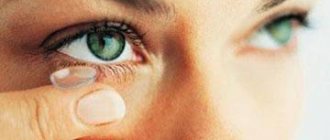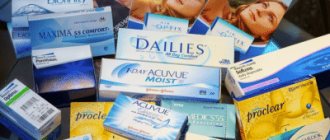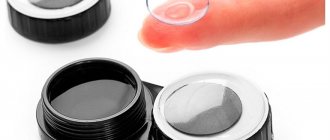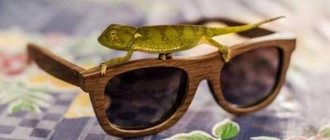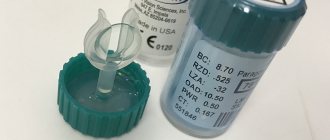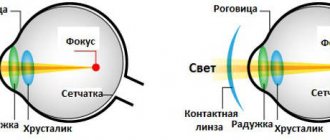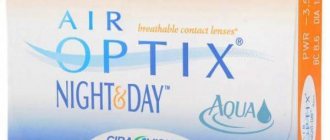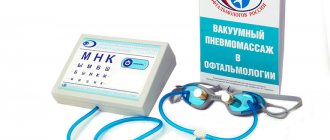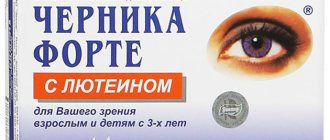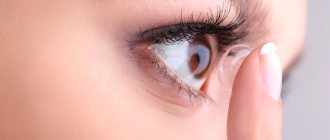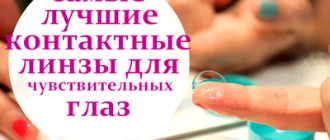Created: 05/17/2019
Updated: 02/19/2021 18:42:21 Share:
*Review of the best according to the editors of expertology.ru. About the selection criteria. This material is subjective in nature, does not constitute advertising and does not serve as a purchase guide. Before purchasing, consultation with a specialist is required.
Hydrogel lenses allow better vision and are suitable as daily disposable lenses. Today they are produced by numerous contact optics companies. Let's find out which models are worth considering for purchase, what are their disadvantages and advantages.
What are silicone hydrogel contact lenses?
Soft contact lenses were created in the 1960s and 1970s through the development of hydrophilic polymers, large molecules synthesized from repeating units (like a chain of repeating radicals). Such a molecule was called a “hydrophilic gel” or simply “hydrogel”. The disadvantage of hydrogel lenses is their inability to transmit oxygen.
Silicone Hydrogel is the latest in a line of products designed to improve oxygen permeability (increases comfort, durability and visual perception), hydration (increases comfort) and clinical performance of contact lenses. Silicone has high oxygen permeability (Dk), allowing access of oxygen and water components to the eyes.
Features of hydrogel lenses
Optical products based on hydrogel are in great demand due to their composition and lack of discomfort even during long-term wear.
Compound
To manufacture the presented models, hydrogel polymers (special gel and water) are used. These materials provide comfortable wearing as they are compatible with ocular tissues.
Thanks to innovative technologies, it has become possible to use not only one polymer in manufacturing, but also to combine it with others. You can also include a number of auxiliary components in the composition, including hyaluronic acid. It promotes eye hydration and comfort.
Types of silicone hydrogel
There are many types and even generations of silicone hydrogel from which contact lenses are made today. Silicone hydrogel has various technical names, such as califikon, senofilkon, comfilkon, enfilkon, etc.
CooperVision contact lenses are 3rd generation silicone hydrogel soft contact lenses*.
Generations of contact lens materials:
1st generation = Treated surface, high oxygen permeability Dk, high elastic modulus, low moisture content.
2nd generation = Surface treated or wetting agent, medium to high oxygen permeability Dk, low elastic modulus, low moisture content.
3rd generation = No surface treatment, high oxygen permeability Dk, low modulus of elasticity, optimal moisture content.
All contact lenses, regardless of material, must be approved by the US FDA (and/or local regulatory authorities in other countries) and approved for specific uses and replacement conditions. Silicone hydrogel improves comfort in most cases and can be used long-term, but ask your optician about which contact lenses are right for you.
How to wear these lenses correctly
Do not forget that if you purchased daily lenses, then you must observe the daily frequency of replacing them. Although silicone hydrogel is famous for the fact that it can be worn for quite a long time, one-day solutions are thinner and have a slightly different structure, so you should not stretch them while wearing them, otherwise unwanted microbes may appear that will harm the eyes, and there is also a risk ingrowth of blood vessels into the cornea. Every morning you take out a new pair of lenses specially selected for you from the blister, carefully put them on, and before going to bed, take them off and throw them away. Many people mention that they have worn daily lenses for up to a month without negative consequences, but this is a risky activity and is strongly discouraged.
Often people go to bed not only at night, but also take short breaks to sleep during the day. In this case, silicone hydrogel lenses may not be removed, but after waking up you may feel slight discomfort.
This is fine. You just need to use specialized eye drops after waking up, which will moisturize your eyes and remove discomfort.
Benefits of silicone hydrogel contact lenses
- High oxygen permeability helps ensure healthy wearing and keep your eyes white**
- High moisture content provides excellent moisture, high wettability, which increases wearing comfort**
- Low modulus of elasticity provides greater softness of the lens, which improves comfort***
Also, the 3rd generation material* allows for different modes of wearing contact lenses. For example, premium Biofinity contact lenses have several wearing modes - daily, extended (up to 7 days/6 nights), continuous (up to 30 days/29 nights). The mode of wearing contact lenses is determined according to the recommendation of a specialist in the selection of contact lenses.
Hydrogel lenses
The main substance is water, so the lenses are not hard and do not cause discomfort when worn. They retain moisture and form a protective film. They have a small elastic modulus and oxygen transmission coefficient.
Products are manufactured for vision correction. The material used for production does not cause allergic reactions or rejection. It is soft, there is no feeling of discomfort and is not felt on the eyes.
The lenses are thin and do not move or curl when blinking. Do not interfere with the work of the upper eyelid. Hydrogel is an elastic and elastic material that does not cause additional pressure on the cornea.
Wearing period: one day, two weeks, monthly and quarterly, long-term use. The optics have a spherical design, but can also be found with an aspherical one.
Examples of lenses:
- DAILIES AquaComfort Plus;
- Biomedics 55;
- 1 day ACUVUE MOIST;
- Optima FW.
Flaws
Water evaporates quickly when worn, causing discomfort to the user.
Some people have to carry moisturizing drops with them. These vision correction products have low oxygen permeability. This is the main drawback. It does not allow flexible or extended wear of hydrogel lenses.
The contact lens does not have its own blood vessels; the necessary oxygen comes from the air. With prolonged use, hydrogel products lead to oxygen deficiency and the development of hypoxia.
Such optics quickly accumulate protein and fat deposits. It must be washed daily with a special solution.
Choice of silicone hydrogel
There are a wide variety of silicone hydrogel materials, each designed for different areas of vision correction and wearing conditions. You need to consult with a specialist in an optical salon, and he, knowing the advantages of silicone hydrogel materials, will help you choose the appropriate lenses. It is important to ensure that the use of these contact lenses and replacement intervals are approved or approved by the US FDA (and/or local regulatory authorities). All contact lenses must be prescribed by a contact lens fitter.
*Based on materials: B. Chau. The Evolution of Silicone Hydrogel Lenses, Contact LensSpectrum, June 2008; Nicole Carnt - B. Wholesale. Silicone hydrogel lenses 3rd generation, May 2008. **High oxygen permeability makes eyes whiter and clearer. Data from CooperVision, 2021. ***Data from CooperVision, 2021.
The information in this article does not constitute medical advice and does not replace the instructions of a qualified specialist. If you have any questions, please contact a specialist at the optical salon.
The best lens models for people with hypersensitive eyes
Main attention should be paid to the following lens parameters:
Oxygen permeability
For normal metabolism in the visual organ, it is very important that oxygen has full access to the eyes. The cornea, as an avascular structure, is nourished by oxygen, which dissolves in tears. Lenses can limit this access, so you need to choose models with a high level of breathability.
High levels of moisture content and oxygen permeability of contact lenses provide a comfortable feeling when used
There is such a thing as “breathable” lenses. These are models with a very thin structure, usually made of soft silicone hydrogel polymers. At a norm of 80 Dk/t (oxygen permeability index), “breathable” lenses have values of up to 175 Dk/t.
Hydrogel lenses have a lower permeability index and are therefore less commonly prescribed to patients who require breathable lenses.
Moisture content
To ensure that the lenses remain moisturized throughout the day and do not dry out the surface of the eyes, materials are added to their composition that retain moisture inside. Such lenses are especially recommended for patients with dry eye syndrome and people who are at risk, for example, office workers.
Contact lenses for sensitive eyes: recommendations from ophthalmologists
A selection of the best contact lenses for people with hypersensitive eyes according to ophthalmologists of the Happy Look network.
- Dailes Total 1
are daily lenses that have 156 Dk/t breathability and 80% moisture content. The lenses are made of modern water-gradient material, which ensures uniform distribution of moisture on the inner and outer surfaces of the lenses. The lenses are designed for daytime wear, but even after a busy day the eyes do not feel tired. There are standard, multifocal and toric models. Manufacturer – Alcon; - Acuvue Oasys with HydraClear Plus
- available for one day and two weeks, in addition to a high level of oxygen permeability and good hydration, they have protection against ultraviolet rays. The model line includes standard and astigmatic lenses. Manufacturer: Johnson&Johnson; - Acuvue TruEye
- daily lenses of the Acuvue brand, have a thickness of only 0.07, thanks to which they provide the eyes with a sufficient level of oxygen. Manufacturer: Johnson&Johnson; - Biofinity
- Although these lenses are designed to last a full month of use, they are often prescribed to patients with high sensitivity of the ocular surface. Experts note that Biofinity lenses have no analogues among other monthly lenses and in terms of quality characteristics can be close to daily lenses. The high comfort of use is explained by the unique oxygen permeability of 160 Dk/t, moisture content of 48% and thickness of 0.08. In addition, the lenses have an aspherical design, which improves the quality of vision. Manufacturer: Cooper Vision.
Why silicone hydrogel lenses allow oxygen to pass through
When a patient puts on hydrogel lenses, oxygen access to the cornea is ensured only if tear fluid enters the space under the lens. Its circulation is ensured mainly by the so-called sublens pump. If the user chooses silicone hydrogel lenses, oxygen is supplied to the cornea directly through the lens material. This is perhaps one of the few qualities that is common to all silicone hydrogel lenses. How was it possible to achieve such an amazing property for artificially created materials?
According to scientists, the introduction of siloxanes into the hydrogel material would significantly increase its oxygen permeability. This would be a serious step forward in solving problems associated with hypoxic complications. Such implementation in itself was not an easy task and, in addition, inevitably led to the fact that the surface of the lenses became hydrophobic, since siloxanes are hydrophobic by nature. There was a need to find a way to provide the surface of a silicone hydrogel lens with such a property as wettability.
All the first attempts by developers of silicone hydrogel lenses to impart the necessary properties to their surfaces ended in failure: the hydrophilic molecules of the coating were “drawn” inward, the surface again became hydrophobic, and when wearing the lenses the user felt a feeling of discomfort. This problem was successfully solved after the creation of the monomer 1,1,1-tris(trimethylsiloxy)-methacryloxypropylsilane (TRIS), which also served as the basis for the Tanaka monomer, which included a hydrophilic group. It provided the latter with better compatibility with the main component of hydrogel materials – the monomer 2-hydroxyethyl methacrylate (HEMA). Although these developments were available for production in the early 1980s, it took approximately 15 more years before the major companies CIBA Vision and Johnson & Johnson Vision Care began to develop their own technologies for creating silicone hydrogel lenses based on the TRIS monomer. In 1999, the first generation of silicone hydrogel lenses appeared on the market.
First generation
These lenses include the first Pure Vision lenses (Bausch & Lomb), made from balafilcon A, and Night & Day (CIBA Vision), made from lotrafilcon A. The latter are today marketed under the Air Optix Night & Day brand " To obtain balafilcon A, TRIS monomer molecules were embedded in a silicone elastomer. As a result, the oxygen permeability of the material was 99 Barrer.
continues to develop and today offers consumers “Pure Vision” lenses, which, in fact, are new silicone hydrogel lenses with the same name. Thanks to the aspherical design of the front surface, they almost completely eliminate spherical aberrations and thereby improve the quality of vision. The lenses also became significantly more comfortable due to a smoother surface and a lower elastic modulus, which decreased by 28%.
To create lotrafilcon A, specialists combined the TRIS monomer with fluorosiloxane and obtained a material with an unusually high oxygen permeability value (140 Barrer). Lotrafilcon A is a two-phase material in which fluorosiloxane provides oxygen access to the eye, and moisture provides tear exchange and removal of deposits. In terms of optical properties, two-phase lotrafilcon A is in no way inferior to single-phase polymers.
This product marked the beginning of the era of silicone hydrogel contact lenses, but these lenses still meet the needs of many patients. Pure Vision and Air Optix Night & Day lenses are FDA approved for continuous wear for up to 30 consecutive days. These products will be useful to patients if the specifics of their work, lifestyle and habits require the use of contact lenses in an extended wear mode.
This wearing mode is well suited, for example, for truck drivers who can be on the road for up to several weeks at a time. They will not have to worry about the risk of any infection when removing and putting on lenses. In addition, the aspheric design of the Pure Vision lenses also benefits users, which improves vision at night and thereby significantly reduces the likelihood of accidents on the road.
Second generation
The second generation includes Acuvue Advance and Acuvue Oasys lenses (Johnson & Johnson Vision Care), made from halifilcon A and senofilcon A, respectively. To create these materials, the manufacturing company used Tanaka monomer combined with siloxane macromers, hydrophilic monomers HEMA and DMA. The wetting agent polyvinylpyrrolidone was introduced into the lens material.
As a result, the oxygen permeability of Halifilcon A was 60 Barrer; lenses made from this material had a fairly high moisture content - 47%. The most advanced second-generation silicone hydrogel lenses, Acuvue Oasys, have an oxygen transmission rate of 147 Barres/cm. These lenses also feature record smoothness and excellent wettability, made possible by the use of patented next-generation Hydraclear Plus technology.
Due to their characteristics, Acuvue Oasys lenses are well suited for wearing in adverse conditions that cause dryness and irritation of the eyes. The occurrence of such unpleasant symptoms is often caused by long hours of work at the computer, increased dryness of indoor air, and a polluted environment. Despite all these factors, many patients wear Acuvue Oasys lenses so comfortably that they even forget they are there.
